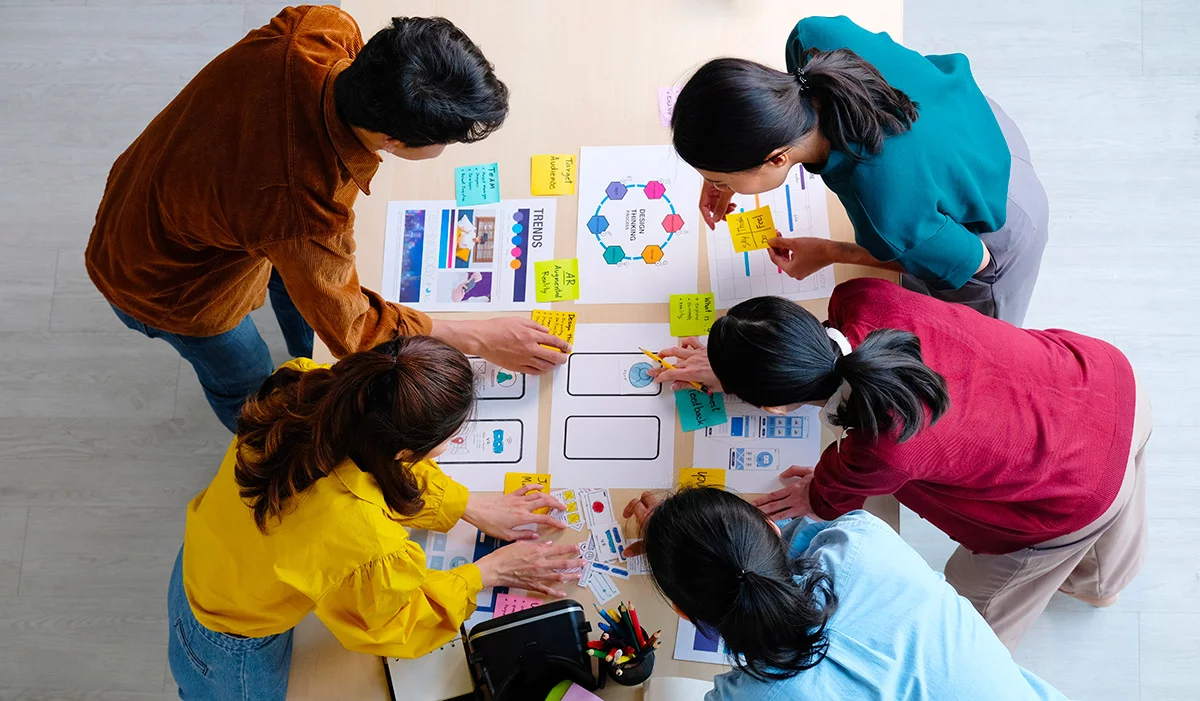Summary – Faced with Swiss quality standards and global competition, companies must structure digital innovation without spreading their teams too thin or losing sight of the user. Design Thinking is structured around on-the-ground empathy, precise framing, controlled ideation, rapid prototyping and testing, while aligning design, IT, and business units through a modular architecture and open-source building blocks.
Solution: implement cross-functional Design Thinking workshops integrated into an agile framework to accelerate time-to-market, reduce project risks, ensure scalability, and maximize ROI.
In a context where digitalization has become a strategic imperative, Design Thinking proves to be an effective method for structuring innovation and avoiding the pitfalls of overly improvised workshops. This approach places the user at the heart of the process while ensuring coherence with technical constraints and business objectives. Swiss companies, facing global competition and high quality standards, find in it a framework to align all stakeholders. Through a proven methodology, it is possible to accelerate the creation of robust, scalable digital services and products tailored to the real needs of end users.
Design Thinking, a Structured Innovation Lever Beyond Brainstorming
Design Thinking is more than just a collection of ideas; it is a methodical process based on empathy and rapid testing. It brings together user, technological, and business dimensions to ensure relevant solutions.
Immersion and Empathy
The first phase focuses on gaining a deep understanding of the user context. Interviews, field observations, and active-listening workshops are organized to uncover motivations, frustrations, and latent needs. This participatory approach involves both business and IT teams from the outset, allowing multiple perspectives to intersect and preventing misunderstandings during the design phase.
Beyond standard personas, field immersions capture real usage patterns and operational constraints. The goal is not merely to collect data but to interpret subtle cues that will guide the rest of the project. This is where the relevance of the proposed digital solution is determined.
Thanks to this structured empathy, cognitive biases are minimized, allowing focus on genuine issues. The outputs of this phase are synthesized into empathy maps and user journeys, which serve as the guiding thread for all subsequent stages.
Problem Definition and Framing
After exploration, the challenge is to reformulate the problem in a precise, shared manner. The main “pain point” to be addressed is identified and measurable objectives are set. This formalization prevents scope creep and ensures clear alignment among IT teams, product management, and business units.
A structured problem definition is achieved through convergence workshops where each stakeholder validates scope and success criteria. Hypotheses are explicitly listed to steer future iterations and anticipate risks.
This stage transforms a general observation into a concrete, operational, and measurable challenge. It lays the groundwork for ideation and reduces the risk of delivering unnecessary or poorly suited features.
Ideation and Controlled Divergence
Next comes the ideation phase, where a wide range of ideas is generated without self-censorship. Sessions are paced with various techniques—from brainwriting to mind mapping—to stimulate collective creativity. The objective is to maximize the diversity of proposals.
To avoid dispersion, time and thematic constraints are imposed. Each idea is then evaluated based on technical feasibility, user value, and business impact. This prioritization matrix serves as a compass for selecting the most promising concepts.
The chosen ideas are sketched out in storyboards or low-fidelity wireframes. This mapping enables quick visualization of the future user journey and sets the stage for prototyping.
Example: A Swiss financial institution seeking to improve SME client onboarding identified a major pain point in manual data entry. Through a series of empathy and ideation workshops, it defined a new digital journey that included automatic document capture and real-time verification. This process reduced account opening time by 70% during the pilot.
Integrating Design Thinking into the Digital Strategy Process
Design Thinking structures the product journey from ideation to production, fostering interdisciplinary collaboration. It fits within an agile, modular framework to accelerate innovation cycles.
Interdisciplinary Collaborative Work
In a digital transformation context, breaking down silos between design, IT, and business is essential. Design Thinking workshops bring these profiles together to ensure every viewpoint is considered, creating a true culture of co-creation.
Roles are clearly defined: a facilitator guides the sessions, a business expert provides process knowledge, and a product owner ensures alignment with business objectives. This setup balances creativity with rigor.
This way of working boosts team buy-in, as everyone feels invested in the project. Decisions are made with full awareness, reducing resistance to change and smoothing technical implementation.
Fast Iterations and Prototyping
A key advantage of Design Thinking is rapid prototyping. Low-fidelity mockups or proofs of concept are built with open source tools to test hypotheses. This velocity quickly reveals potential blockers.
Each iteration incorporates early user feedback. Adjustments are made in days without heavy development commitments. This minimizes resource waste and optimizes time-to-market.
The methodology is ideally complemented by CI/CD pipelines, ensuring continuous integration of validated prototypes. This approach reduces development costs and paves the way for scaling up to an industrial version.
Validation and User Testing
Before any large-scale deployment, testing sessions are held with a representative panel of users. Interactive prototypes are evaluated based on usability and ergonomics criteria.
Functional or ergonomic pain points are addressed at this stage, using both qualitative and quantitative metrics. Feedback is recorded in a prioritized backlog to guide subsequent development.
This approach guarantees the final solution meets real needs and minimizes post-launch rework, avoiding extra costs and loss of trust.
Example: A Swiss pharmaceutical lab adopted this approach to redesign its internal training portal. Prototype iterations tested with employees and quality managers refined the interface and reduced IT support queries by 50% during the national rollout.
Edana: strategic digital partner in Switzerland
We support companies and organizations in their digital transformation
Concrete Benefits of Design Thinking Workshops for IT, Product, and Business Leaders
A well-structured Design Thinking workshop significantly reduces project risks and accelerates time-to-market. It also boosts stakeholder engagement and prioritizes high-ROI features.
Project Risk Reduction and Stakeholder Alignment
By involving all key actors from the start, a shared vision of scope and objectives is created. Hypotheses are validated before any development, reducing the risk of scope creep and costly rework.
This clarity strengthens governance, as decisions are documented and backed by user data. Trade-offs become quicker and more transparent for steering committees.
Over time, this discipline lowers the failure rate of digital projects and improves adaptability to changing contexts or strategies.
Accelerated Time-to-Market
Rapid prototyping and short cycles facilitate early production releases. Workshop-validated features can be industrialized in parallel thanks to a modular architecture and continuous integration pipelines.
This flexibility enables launching an MVP in weeks, gathering real feedback, and adjusting the product roadmap. Companies thus gain weeks or even months on the initial schedule.
This agility is a decisive competitive advantage in fast-evolving markets.
End-User Engagement and Adoption
Including future users in workshops fosters co-creation. They feel heard and see their needs addressed. This generates buy-in and eases adoption of digital solutions.
Training materials and documentation can be developed from initial user feedback, reducing post-launch support needs and improving the onboarding experience.
In the long run, the company gains a base of ambassador users ready to promote the solution internally and externally.
Example: A Romandy-based real estate company used Design Thinking to revamp its online client portal. Agile management and user testing increased digital account activation by 30% while cutting customer service calls for interface assistance by 40%.
Informed Technology Choices and Robust Software Architecture through Design Thinking
Design Thinking guides technology choices toward modular, open source, and hybrid solutions to avoid vendor lock-in. It also steers the definition of a scalable, secure architecture.
Modular and Scalable Architecture
Mapping user journeys and features identifies critical domains to isolate into microservices. This granularity simplifies maintenance, scalability, and independent evolution of each component.
Such architecture limits the impact of incidents and streamlines version upgrades. It relies on containers and orchestrators to ensure optimal resilience and flexibility.
By adopting this modularity from ideation onward, future needs are anticipated, building a digital foundation that can evolve without a complete overhaul.
Selection of Suitable Open Source Components
Design Thinking can also include technology evaluation during ideation. Mature open source solutions with strong communities and regular updates are favored.
This approach reduces dependency on a single vendor and offers customization freedom. Libraries are chosen based on business alignment and technical compatibility.
Processes for monitoring and automated updates are implemented to ensure long-term sustainability and security of the stack.
Hybridization and Avoiding Vendor Lock-In
To meet specific constraints, existing components can be combined with from-scratch development. This hybrid approach retains the agility of off-the-shelf solutions while ensuring precise customization.
Interfaces are standardized via open APIs, making future component replacement seamless. The ecosystem remains flexible, modular, and adaptable to strategic shifts.
Clear governance over contracts, licenses, and data exchange completes this approach to control total cost of ownership and mitigate lock-in risks.
Example: A Swiss retail group re-architected its e-commerce platform through a Design Thinking approach, decoupling the product catalog, promotions engine, and payment system. This open source–based modularity enabled 200% load growth during promotional peaks without major incidents.
Design Thinking: Make It the Accelerator of Your Digital Innovation
Design Thinking provides a robust framework to ideate, prototype, and industrialize user-centered digital solutions while integrating technological and business challenges from the start. It strengthens collaboration, accelerates innovation cycles, and reduces project risk through early validation.
This method also guides architectural and technology decisions toward modular, open source, and hybrid ecosystems, ensuring solution scalability and resilience. IT, product, and business leaders thus benefit from optimal alignment and shortened time-to-market.
CIOs, CTOs, CEOs, and product managers looking to transform ideas into high-performance digital projects will find in this approach a powerful lever to maximize ROI and anticipate future developments.
At Edana, our experts are available to support you in setting up tailored Design Thinking workshops and structuring your digital innovation process.







 Views: 1494
Views: 1494